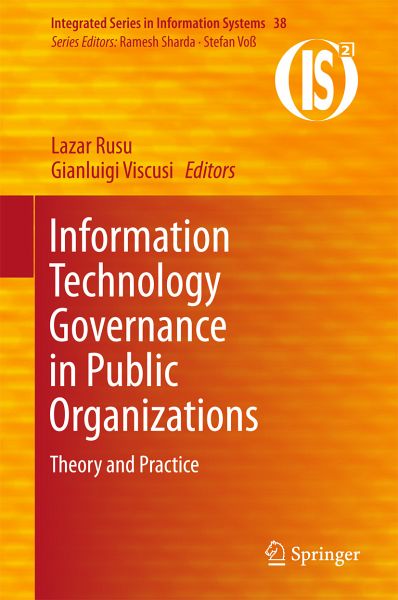
Information Technology Governance in Public Organizations (eBook, PDF)
Theory and Practice
Redaktion: Rusu, Lazar; Viscusi, Gianluigi
Versandkostenfrei!
Sofort per Download lieferbar
72,95 €
inkl. MwSt.
Weitere Ausgaben:

PAYBACK Punkte
36 °P sammeln!
This book examines trends and challenges in research on IT governance in public organizations, reporting innovative research and new insights in the theories, models and practices within the area. As we noticed, IT governance plays an important role in generating value from organization's IT investments. However there are different challenges for researchers in studying IT governance in public organizations due to the differences between political, administrative, and practices in these organizations.The first section of the book looks at Management issues, including an introduction to IT gove...
This book examines trends and challenges in research on IT governance in public organizations, reporting innovative research and new insights in the theories, models and practices within the area. As we noticed, IT governance plays an important role in generating value from organization's IT investments. However there are different challenges for researchers in studying IT governance in public organizations due to the differences between political, administrative, and practices in these organizations.
The first section of the book looks at Management issues, including an introduction to IT governance in public organizations; a systematic review of IT alignment research in public organizations; the role of middle managers in aligning strategy and IT in public service organizations; and an analysis of alignment and governance with regard to IT-related policy decisions.
The second section examines Modelling, including a consideration of the challenges faced by public administration; a discussion of a framework for IT governance implementation suitable to improve alignment and communication between stakeholders of IT services; the design and implementation of IT architecture; and the adoption of enterprise architecture in public organizations.
Finally, section three presents Case Studies, including IT governance in the context of e-government strategy implementation in the Caribbean; the relationship of IT organizational structure and IT governance performance in the IT department of a public research and education organization in a developing country; the relationship between organizational ambidexterity and IT governance through a study of the Swedish Tax Authorities; and the role of institutional logics in IT project activities and interactions in a large Swedish hospital.
The first section of the book looks at Management issues, including an introduction to IT governance in public organizations; a systematic review of IT alignment research in public organizations; the role of middle managers in aligning strategy and IT in public service organizations; and an analysis of alignment and governance with regard to IT-related policy decisions.
The second section examines Modelling, including a consideration of the challenges faced by public administration; a discussion of a framework for IT governance implementation suitable to improve alignment and communication between stakeholders of IT services; the design and implementation of IT architecture; and the adoption of enterprise architecture in public organizations.
Finally, section three presents Case Studies, including IT governance in the context of e-government strategy implementation in the Caribbean; the relationship of IT organizational structure and IT governance performance in the IT department of a public research and education organization in a developing country; the relationship between organizational ambidexterity and IT governance through a study of the Swedish Tax Authorities; and the role of institutional logics in IT project activities and interactions in a large Swedish hospital.
Dieser Download kann aus rechtlichen Gründen nur mit Rechnungsadresse in A, B, BG, CY, CZ, D, DK, EW, E, FIN, F, GR, HR, H, IRL, I, LT, L, LR, M, NL, PL, P, R, S, SLO, SK ausgeliefert werden.












